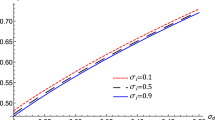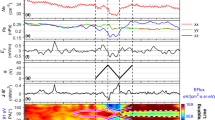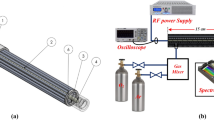Abstract
IT has been found that the self-magnetic field associated with the flow of current in a low-pressure discharge (mercury vapour at less than 2 × 10−3 mm. pressure) plays an important part in determining the radial density distribution at currents as low as 30 amp. The effect of this magnetic field can be treated by adding a ‘magnetic potential’ term  to the electrostatic potential Vs in the Boltzmann equation, w̄1 being the longitudinal electron-drift velocity. The drift of electrons and ions to the tube walls is equalized at low arc currents by a radial electric field. Since the self-magnetic field tends to reduce the drift of electrons to the walls while having a negligible influence on the positive ions, increasing the arc current leads to a progressive reduction in the radial electric field.
to the electrostatic potential Vs in the Boltzmann equation, w̄1 being the longitudinal electron-drift velocity. The drift of electrons and ions to the tube walls is equalized at low arc currents by a radial electric field. Since the self-magnetic field tends to reduce the drift of electrons to the walls while having a negligible influence on the positive ions, increasing the arc current leads to a progressive reduction in the radial electric field.
This is a preview of subscription content, access via your institution
Access options
Subscribe to this journal
Receive 51 print issues and online access
$199.00 per year
only $3.90 per issue
Buy this article
- Purchase on SpringerLink
- Instant access to full article PDF
Prices may be subject to local taxes which are calculated during checkout
Similar content being viewed by others
References
Tonks, L., Phys. Rev., 56, 360 (1939).
Author information
Authors and Affiliations
Rights and permissions
About this article
Cite this article
THONEMANN, P., COWHIG, W. High-Current Gas Discharge at Low Pressures. Nature 166, 903–904 (1950). https://doi.org/10.1038/166903a0
Issue date:
DOI: https://doi.org/10.1038/166903a0



